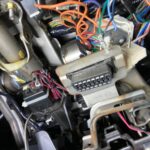Seeing the “check engine” light illuminate on your Chevrolet’s dashboard can be unsettling. Understanding OBD2 trouble codes (Códigos De Falla Obd2 Chevrolet) is crucial for diagnosing and addressing the issue. This guide provides a comprehensive overview of Chevrolet OBD2 codes, explaining their structure, meaning, and how to interpret them.
What are OBD2 Trouble Codes?
OBD2, or On-Board Diagnostics II, is a standardized system that monitors your Chevrolet’s engine and emissions systems. When a problem is detected, the system generates a specific alphanumeric code, known as a Diagnostic Trouble Code (DTC), stored in the vehicle’s computer. These códigos de falla obd2 chevrolet pinpoint the source of the problem, allowing mechanics and vehicle owners to identify and fix the issue.
Deciphering Chevrolet OBD2 Codes
Chevrolet OBD2 codes, like all standard OBD2 codes, follow a specific five-character format:
-
First Character (Letter): Indicates the system where the fault is detected:
- P: Powertrain (engine, transmission, fuel system) – Most common for Chevrolet vehicles.
- B: Body (airbags, power seats, lighting)
- C: Chassis (ABS, steering, suspension)
- U: Network Communication (modules, wiring)
-
Second Character (Number):
- 0: Generic code (SAE – Society of Automotive Engineers standard), applicable to all OBD2 compliant vehicles, including Chevrolet.
- 1: Manufacturer-specific code (unique to Chevrolet).
-
Third Character (Number): Identifies the specific subsystem related to the fault:
- 1: Fuel and Air Metering
- 2: Fuel and Air Injection System
- 3: Ignition System or Misfire
- 4: Auxiliary Emissions Controls
- 5: Vehicle Speed Control and Idle Control System
- 6: Computer Output Circuit
- 7 & 8: Transmission or Transaxle
-
Fourth and Fifth Characters (Numbers): Pinpoint the exact problem within the subsystem (e.g., P0301 indicates a misfire in cylinder 1).
Common Chevrolet OBD2 Codes
While numerous códigos de falla obd2 chevrolet exist, some occur more frequently:
- P0420: Catalyst System Efficiency Below Threshold (Bank 1) – Often indicates a failing catalytic converter. Common in older Chevrolet models.
- P0171: System Too Lean (Bank 1) – Indicates a lean air/fuel mixture, potentially due to a vacuum leak or faulty oxygen sensor.
- P0300: Random/Multiple Cylinder Misfire Detected – Can be caused by various issues, including spark plugs, ignition coils, or fuel injectors. Common across various Chevrolet engines.
- P0135: O2 Sensor Heater Circuit Malfunction (Bank 1, Sensor 1) – Indicates a problem with the oxygen sensor’s heating element.
Using an OBD2 Scanner for Chevrolet Diagnostics
An OBD2 scanner is essential for retrieving and interpreting códigos de falla obd2 chevrolet. Connecting the scanner to your Chevrolet’s OBD2 port (usually located under the dashboard) allows you to access the stored codes. Many affordable scanners are available, providing code definitions and potential causes.
Addressing Chevrolet OBD2 Codes
While understanding códigos de falla obd2 chevrolet is vital, it’s crucial to remember they only indicate the problem’s general area. Further diagnosis is often necessary to identify the root cause. Consulting a qualified mechanic, especially for complex issues, is recommended. Don’t ignore your check engine light. Addressing issues promptly can prevent more extensive and costly repairs down the road. Regular maintenance and timely repairs are essential for keeping your Chevrolet running smoothly.

